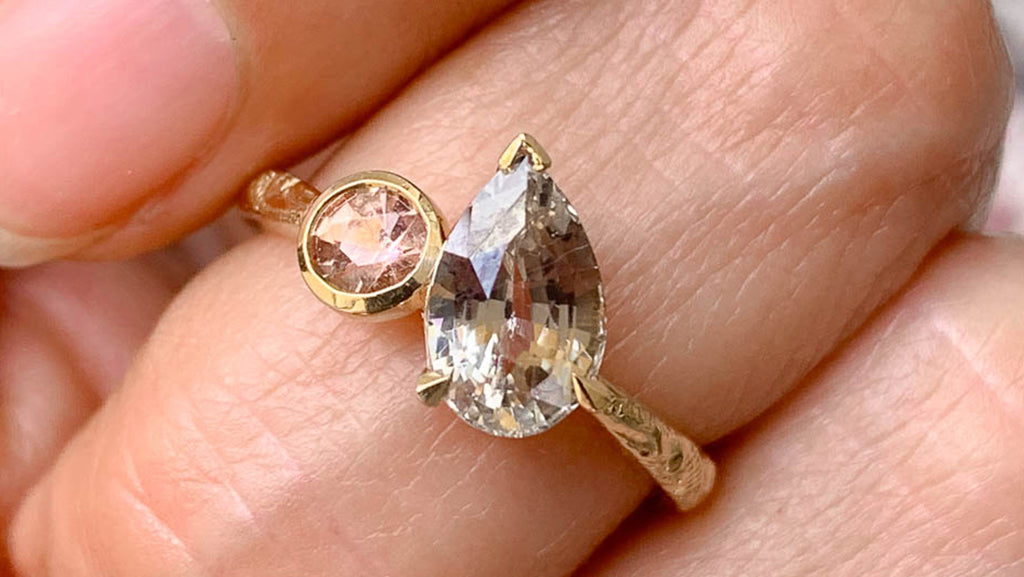Your Cart is Empty

A champagne diamond does exactly as it says on the tin; it’s a diamond with a naturally yellow-brown tint that resembles the colour of champagne.
Generally, any diamond that falls between a K and a Z on the GIA diamond colour scale is referred to as ‘champagne’. You might also notice champagne diamonds graded by an alternative system, introduced by mining corporation Rio Tinto in the 1990s when the GIA and other third party assessors were still not valuing brown diamonds. As per this system, C1 represents the lightest colour of brown and C7 the darkest.
Visually, this means a champagne diamond can range from a subtle nude right through to a deeper, nuttier brown.
The colour of any diamond is the result of trace elements within the crystal structure. Champagne diamonds specifically contain small amounts of nitrogen, trapped during the diamond during formation thousands of years ago. The higher the nitrogen content, the deeper and more saturated the diamond’s shade of brown.
 Sigi’s bespoke engagement ring, set with a 1.8ct champagne diamond dark enough to be deemed a chocolate diamond
Sigi’s bespoke engagement ring, set with a 1.8ct champagne diamond dark enough to be deemed a chocolate diamond
It’s important to remember that natural diamonds graded completely colourless are incredibly rare. In fact, it’s very common for trace elements to enter the crystal structure during diamond formation to instil it with a hue of some kind – especially the nitrogen responsible for yellow-brown tinges. For a long time, diamonds have been valued for their ‘perfection’; the lower on the GIA colour scale a diamond is graded, the higher its price and desirability. In fact, the abundance of brown diamonds historically deemed them so undesirable that they were used only for industrial purposes.
It was not until the 1960s that Baumgold Bros., an NYC-based diamond cutter and fine jewellery importer, rebranded brown diamonds in order to entice sales. Names included champagne, amber, cognac and chocolate. Other companies soon followed the Baumgold Bros. lead and introduced the notion of shades such as clove, coffee, caramel, cappuccino, mocha, espresso, cinnamon and even tobacco; a redirection that saw some initial success, before the multitude of names ultimately caused confusion in the marketplace.
In the late 1980s a savvy marketing expert working at Western Australia’s Argyle Mine once again coined the phrase ‘champagne diamonds’ in a bid to pique consumer interest in the masses of brown diamonds the mine was producing at the time – which constituted as many as 80% of the mine’s total output. Welcoming an influx of sales from fashion jewellery retailers and mall jewellers, Argyle very quickly forged a newfound respect for these previously low-status diamonds, driving a whole different price point for diamond jewellery.
Technically, the only difference between a champagne diamond today and a brown diamond once crushed down to abrasive granules for cutting ‘better’ diamonds 50 years ago is the name we now refer to it with. As such, fine jewellery company Le Vian trademarked the term Chocolate Diamond® in 2000, driving an increase for searches of ‘brown diamonds’ by almost 400,000% in just seven years. Le Vian is stringent about the criteria of a Chocolate Diamond – it must rate between a C4 and C7 on the Argyle colour scale and show a certain hue, tone and saturation that’s much darker than champagne diamonds. ‘Champagne diamond,’ on the other hand, is a non-trademarked term used more broadly to refer to a wider spectrum of brown diamonds.
At the end of the day, it’s all about storytelling – this conscious change in perspective is what has driven demand for the champagne-hued gemstones that were once typically devalued for their natural tint.

Although our attitudes towards brown-tinted diamonds have evolved over the years, champagne diamonds are generally still cheaper than their colourless counterparts. There are a few reasons for this.
Firstly, the diamond standard of ‘perfection’ will always pertain to colourlessness and extreme clarity. No matter how subjectively beautiful, other diamonds that grade lower in the categories of Cut, Clarity and Colour are comparatively less valuable. That in itself is down to rarity – champagne diamonds are more abundant than those without colour. What’s more, a darker tint helps to mask a multitude of inclusions, which means a champagne diamond could score pretty low on the Clarity scale – thus nudging its price down – whilst still looking beautiful.

Precious metals and gemstones are formed over deep time through complex geological and cosmic processes. They are survivors of the immense timescales of the universe’s evolution – and reminders of the comparative limitation of human experience. Whether rare and colourless or abundant and brown-tinted, diamonds are the fruit of our planet’s womb and we cherish them for that. It’s fascinating to us that brown hues are the result of nitrogen edging its way into the crystal formation whilst a diamond comes to life over thousands of years!
From a design perspective, the relative affordability of champagne diamonds also allows for more freedom. For those on a budget, a champagne diamond is an opportunity to enjoy the diamond’s resilience whilst welcoming a larger carat weight.
